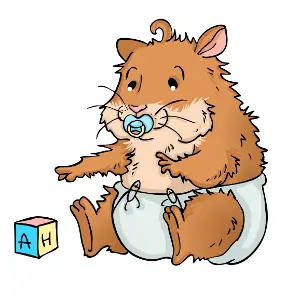In this guide
The hamster life cycle may not be very long, but they do have lives which are full of fun!
The longest lived hamster on average is the Roborovski dwarf hamster. They live for an average of 3 to 3.5 years.
On average, different types of hamster live for the following amounts of time…
Roborovski Hamster: 3 to 3.5 years
Syrian Hamster: 2 to 2.5 years
Campbell’s Dwarf Hamster: 2 years
Chinese Hamster: 1.5 to 2 years
Winter White Russian Dwarf Hamster: 1.5 to 2 years
Though these are only averages, the life span of individual hamsters can vary quite considerably.
So, you know approximately how long your hamster is likely to live, but do you know what will happen during its life?
The hamster life cycle is really interesting, and although you may not have your pet from birth it’s good to know about the entire life process.
The birth of a hamster
After a short gestation period, hamsters are born in varying sizes of litter from one up to as many of twenty babies! Hamster babies are known as pups.
 At birth hamsters are very vulnerable as they are blind and deaf and they don’t have any fur. A hamster’s fur only starts to appear when it is approximately five days old and their eyes don’t start to open until they are two weeks old.
At birth hamsters are very vulnerable as they are blind and deaf and they don’t have any fur. A hamster’s fur only starts to appear when it is approximately five days old and their eyes don’t start to open until they are two weeks old.
Once their eyes are open, they grow more independent in their exploration. However, they continue to be reared by their mother until they are between 21 and 28 days old.
While very young hamsters will need to be fed by their mother if at all possible, did you know that you can get small “nursing bottles” to feed young hamsters?
After 28 days, it’s very important for hamsters to be removed from their mother’s care and, in the case of Syrian hamsters, separated to live as individuals.
Syrian hamsters always need to be housed separately as they fight if they are together.
It’s usually fine to keep dwarf hamsters together (though you should still watch out for any fighting) but you need to realise that, although they may not have been born very long ago, hamsters reach sexual maturity when they are just 4 to 6 weeks old. It’s therefore a good idea to keep males and females separate as they head into adolescence.
The adolescence of a hamster
Although hamsters are sexually mature from between 4 to 6 weeks of age, with males maturing faster than females, it’s not a good idea to let females breed before they reach 10 weeks of age.
Sadly, female hamsters that breed earlier than this are prone to giving birth to still born pups.
It’s also important to note that a female hamster can become pregnant again within just 24 hours of giving birth, so it’s a good idea to separate her from the male hamster!
The prime of a hamster’s life!
Most hamsters are in the prime of life just before they reach one year old; though this can depend on the life expectancy of the particular breed. At this age, they will usually have plenty of energy and be playful and fun.
Not long after they reach their first birthday they progress on the way to middle and old age. From the age of 12 to 14 months female hamsters can become infertile. Even if this does not happen, if a female has not bred prior to this point then it really is too late. Breeding at this age can lead to problems in the pelvic and hip areas.
The end of the hamster life cycle
 Just like humans, hamsters are more likely to suffer health problems as they get older. But of course, just because a hamster is old does not mean that you shouldn’t still seek help from a vet.
Just like humans, hamsters are more likely to suffer health problems as they get older. But of course, just because a hamster is old does not mean that you shouldn’t still seek help from a vet.
There may not be a cure for whatever is wrong, but it is often possible to manage hamster health problems so that the hamster can still lead a happy life.
There is no guarantee against health problems, but it does help if a hamster is fed correctly, kept in a clean environment, provided with veterinary care when necessary, and generally given a lot of love!